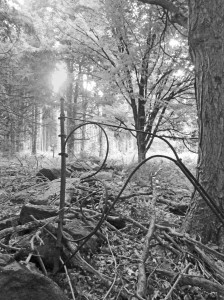It’s Only Natural
Reading the New England Jungle
By Hans M. Carlson
Jean’s Trail, on the western edge of Great Mountain Forest, makes a loop out through the “Raggy Lot,” on what was once the Dean Farm. The Deans were from the Mount Riga area, probably explaining the name. Although the local term “raggy” means “charcoal maker” (and probably derives from the early association of Mount Riga with colliery), the land was never used for charcoal making, like so much of GMF. It was a farm all through the nineteenth century, and when Ted Childs bought the property for GMF in 1939 its fields had recently been abandoned.
Land records give us this general picture, but on this morning we are after something more specific. Michael Gaige, Jonathan “Yoni” Glogower and I are reading the landscape, trying to decipher part of the story written on the land itself since settlement. Yoni is a Yale graduate student, Michael is a consulting naturalist, and they are putting together a fieldbook of interesting natural and cultural sites at GMF. There is a wonderful book called “Reading the Forested Landscape: A Natural History of New England,” by Tom Wessels, which is a primer on the technique they are using. Michael is a former student of Wessels and now himself an expert.
On this site one gets the immediate impression of being on an old homestead because GMF keeps it mowed. There’s a young sugar maple maybe 50 feet high growing in the opening, and stone walls line the trail, but the picture becomes more complete, and far more interesting, if you look more carefully. There are large sugar maple wolf trees, many of them associated with the walls, which likely gave shade as well as sap, when the area was open. There are apple and hawthorn trees, too, and in all these clues you begin to visualize the pastures and fields.
A hundred feet off the trail, there’s the wrought-iron tongue of a horse-drawn carriage leaning against a maple at the end of a wall. It’s near the farm’s cellar hole, now overflowing with bittersweet, ferns, blackberries and Japanese barberry. In the thicket, you might very well miss the cellar hole, but the wall leads you there, helping to define the spatial relations of farm life. It’s all a perfect example of what Mike refers to as “the New England jungle” taking back the land.
From the cellar hole we walk the wall northeast into a GMF plantation. This area was put in red spruce in the early 1960’s by Darrell Russ, the forest manager. In the late 1980’s, the current forest manager, Jody Bronson, thinned the spruce planting, which is now interspersed with sawn stumps and the remains of cabbagy, open-grown white pines that probably started growing when the farm was abandoned in the 1930’s. These were crowding the spruce in the 1980’s, and Bronson girdled them as he thinned, leaving them standing as snag trees for wildlife.
Oral history gives us names here, and Russ recorded that there were potato fields in this area, but it’s fascinating that most of the chronology and land use are clearly legible to Mike’s practiced eye. He points my attention to the small stones in the walls around this part of the plantation. These would not have been cleared and put in the wall if this had been pasture for livestock, so this is likely where the potatoes grew.
The pasture was on the other side of Jean’s Trail, to the north of the spruce plantation. Here the canopy is dominated by young hardwoods, like black birch and sugar maple, and a distinct change in forest type at the edges marks the boundary. The mostly open understory with a heavy ground cover of Canada mayflower is another indicator. The lumpy ground with small outcrops of bedrock also differentiates it from the smooth potato field.
Working with GPS units, Mike and Yoni map the various features and boundaries of the site. They will do a far more complete write-up than this brief sketch, but I am struck by the nineteenth-century image of this place. Last month I wrote about the view from the top of Canaan Mountain, and about what I called the post-industrial landscape left by the iron industry in GMF. Today I am thinking about Mike’s metaphor. We won’t find anything as dramatic as a Mayan ruin or a Toltec pyramid in the jungles of northwest Connecticut, but there are overgrown stories like this one nearly everywhere in this forest.
Photo by Hans M. Carlson.

